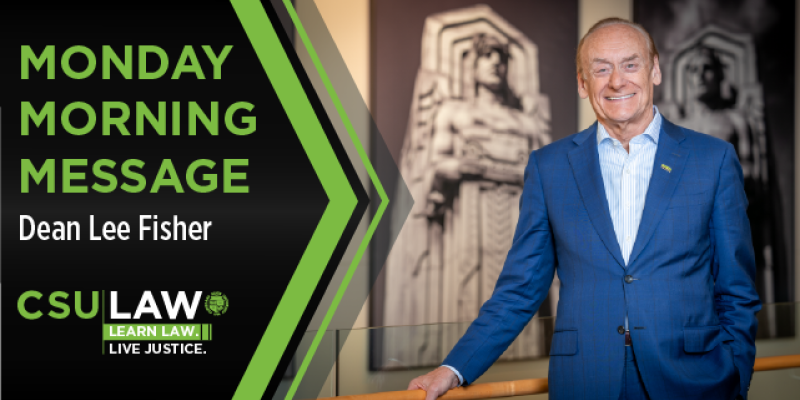
“Equal Justice under the law is not merely a caption on the facade of the Supreme Court building, it is perhaps the most inspiring ideal of our society.” – Former Supreme Court Justice Lewis Powell
In some years, through a very competitive application process, our law school is granted the privilege by the U.S. Supreme Court to host a small group of up to 12 lawyers for an official swearing-in ceremony in Washington D.C. for admission to practice before the U.S. Supreme Court.
This year our law school was granted that privilege, and we invited some of our distinguished alumni to apply. As part of the application process, each applicant was required to have two sponsors who have already been admitted to the bar of the U.S. Supreme Court, and Kelly Tompkins ’81 and I served in that capacity for most of the applicants. I also had the honor of serving as the designated “movant” for the group, which meant that I appear before the Justices and move each applicant’s admission.
On Tuesday morning, April 18, 2023, eleven of our distinguished alumni, Associate Dean Carolyn Broering-Jacobs, our 12 special guests including CSU President Laura Bloomberg, and I arrived at the U.S. Supreme Court at 7:30am. As we approached the entrance, escorted by the Supreme Court police, and passed by the 36 marble steps of one of the most awe-inspiring buildings in the world, we saw the engraved words “Equal Justice Under Law” above the sixteen majestic marble columns.
After a continental breakfast and remarks from the Supreme Court Clerk and the Director of Admissions, we were led to the east end of the Great Hall. We walked through the oak doors that open into the Court Chamber with its 44-foot ceiling, 24 columns, and the mahogany raised Bench behind which the nine Justices of the U.S. Supreme Court sit.
At 9:45am, we took our seats in the chairs on the left side of the Courtroom in the “Bar” section just beyond the brass railing that divides the public section from that reserved for those admitted to the Supreme Court Bar. See Supreme Court Seating Chart. Several rows behind us on the other side of the railing in the public section’s reserved seats were our 12 guests. Representatives of the press were seated on the red benches along the left side of the Courtroom where we saw Nina Totenberg, NPR’s legal affairs correspondent. (Note: the evening before we had dinner with our distinguished graduate Carl Stern '66, who sat on those red benches for 26 years as NBC’s national legal correspondent.)
At 10am, the Courtroom fell silent, and the Marshal, Colonel Gail Curley, brought down her gavel and intoned, “The Honorable, the Chief Justice and the Associate Justices of the Supreme Court of the United States.” The nine Justices walked through openings in the curtains and moved to their seats. The Marshal cried, “Oyez, Oyez, Oyez” (which means “Hear ye”). All persons having business before the Honorable, the Supreme Court of the United States, are admonished to draw near and give their attention, for the Court is now sitting. God save the United States and this Honorable Court.” The gavel fell again, and the Justices and all others in the Courtroom took their seats.
Regardless of your views about the Supreme Court, at that moment, one has a solemn sense that you are now sitting at the altar of the appellate gods.
At about 10:15am, Chief Justice John Roberts, the 17th Chief Justice, announced my name and the name of our law school – Cleveland State University College of Law - and I walked to the lectern just 10 feet from where he and the other eight Justices sat. To my far right sat the newest Justice, Associate Justice Ketanji Brown Jackson, the 104th Associate Justice, and to my far left sat Justice Amy Coney Barrett, the 103rdAssociate Justice.
I spoke slowly, savoring the moment. “Mr. Chief Justice and may it please the Court, I move the admission of the following attorneys: (Note: I did not state their graduation year from CSU|LAW or their title, but I’ve taken the liberty of listing them below)
From the Bar of the State of Illinois:
Michael Todd Fishman (’95, Shareholder, Greenberg, Trauig)
From the Bar of the State of Ohio:
Anthony Joseph Asher (’63, Founder, Weston, Inc.)
Brett P. Barragate (’96, Partner, Jones Day)
Dana C. Barragate (’94, Attorney, Federal Trade Commission)
Carolyn Broering-Jacobs (CSU|LAW Associate Dean for Academic and Student Affairs)
Matthew Van Loan Crawford (’94, Chairman & CEO, ParkOhio)
Julie Ann Crocker (’06, Partner, Taft)
Sarah Flannery (’02, Partner, Thompson, Hine)
Michael James Haas (’94, Partner, Latham & Watkins)
Brenden P. Kelley (’15, Founder/Partner, Brenden Kelley Law)
Robert D. Vilsack (’87, Chief Legal Officer, ParkOhio)
Donna Zapis Thomas (’87, Co-Founder/Managing Partner, Rockport Retirement Community)
“I am satisfied that each possess the necessary qualifications.”
As I read their names, each admittee stood. Chief Justice Roberts granted my motion, and the Clerk of the U.S Supreme Court, Scott Harris, administered the oath of office to the 12 members of our group.
See a group photo and article about our experience on our website: CSU|LAW Alumni Admitted to the U.S. Supreme Court Bar
Now that they have been admitted to the Bar of the U.S. Supreme Court, the benefits include special reserved seating in the Supreme Court Courtroom, access to the Supreme Court Library, and the mic drop of all office decorations for lawyers - an impressive, framed certificate of admission.
Following the swearing-in, we had the special opportunity to watch an hour and 45 minutes oral argument in Groff v. DeJoy. You can listen here: oral argument. The Court hears oral arguments in cases from October through April, so the case we watched Tuesday morning was among the final oral arguments of this term. The case centers on Gerald Groff, an evangelical Christian and U.S. Postal employee who observes the Sunday Sabbath and is therefore unable to work on that day. After the Postal Service made a deal with Amazon to deliver some of the company’s packages on Sundays, Groff was disciplined after he refused to work on Sundays. In the Supreme Court, he is asking the justices to overrule their 1977 decision in Trans World Airlines v. Hardison, holding that employers can show the kind of “undue hardship” needed to overcome the general ban on firing workers for practicing their religion whenever accommodating the religious practice would require more than a trivial or minimal cost. See April 18 Supreme Court Argument About Religious Freedom
In the afternoon, Ellen Grevey, Assistant Dean for Advancement, Keisha Mitchell, Director of Advancement, Elaine Terman, Marketing Director, my wife Peggy Zone Fisher, President/CEO of the Diversity Center of Northeast Ohio, and I had a private tour of the Library of Congress, the largest library in the world with more than 173 million items, led by Elizabeth Pugh ’78, former Chief Counsel of the Library of Congress, and a treasured member of our CSU|LAW Hall of Fame. That evening, we attended a great reception for Washington D.C. area CSU alumni, hosted by the CSU Alumni Association and President Bloomberg.
It was a memorable day in the proud history of our law school that each of us will cherish.
Stay safe. Stay healthy. Stay Committed to Living Justice.
Have a great day. Have a great week.
My best,
Lee
Lee Fisher
Dean, Cleveland State University College of Law | Cleveland State University
Joseph C. Hostetler-BakerHostetler Chair in Law
For copies of past messages, please go to this link: Monday Morning Messages.
